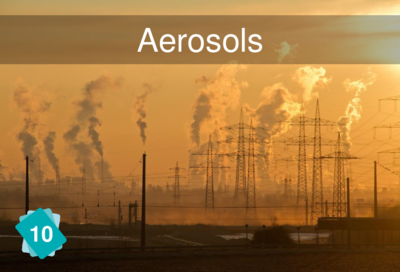En-en adult card 10 aerosols
Card #10: Aerosols
Nothing to do with aerosol spray cans. Aerosols are a type of local pollution that comes from the incomplete combustion of fossil fuels. They are bad for human health and they negatively contribute to radiative forcing, meaning that they have a cooling effect on the climate.
Definitions
Aerosols are solid or liquid particles suspended in the air, generally ranging in size from a few nanometres to 10 micrometres and which remain in the atmosphere for at least several hours. Aerosols can be of natural or human origin (through transportation or industry). They can affect the climate in a variety of ways: directly, by scattering or absorbing radiation, and indirectly by acting as condensation nuclei of clouds or glaciogenic cores, by modifying the optical properties and lifetime of clouds.
Correction
Causes
Consequences
- Radiative forcing Aerosols cool down the climate.
- Human health Although aerosols are not alone in the "fine particle" category, every year 391,000 people in EU countries die from air pollution[1], and it causes 1.1 million premature deaths in India and China[2]. Air pollution such as soot caused by the burning of fossil fuels such as coal and oil was responsible for 8.7m deaths globally in 2018. [3][4]
Other possible links
Other causes
Building usage Buildings emit few aerosols directly. The only significant emissions are chimney fires. In Chamonix, 85% of the fine particles present in the atmosphere come from wood heating[5].
Facilitation advice
This card can be removed most of the time, unless the players are likely to understand it, have the time and the facilitator has a good grasp of the subject.
Card 13 can be used to explain this: Aerosols mainly play on the orange arrows (they increase the size of the "Reflection" arrow, while the additional greenhouse effect plays on the red arrows (it increases the size of the "Greenhouse Effect" arrow which returns to the earth).
To go further
Origins of anthropogenic aerosols
Aerosols are a form of local pollution caused by the incomplete combustion of hydrocarbons. When we burn fossil fuels, a perfect and complete combustion produces only CO2 and water vapour. However, the hydrocarbons we burn are not pure and the combustion is not complete. Therefore, polluting gases such as NOx or carbon monoxide and aerosols such as black carbon (soot) or hydrogen sulphide are also emitted.
Natural Aerosols
If clouds already existed before the industrial era, it is because aerosols exist in their natural state. They are for example microscopic grains of sand, salt crystals, volatile organic compounds (VOCs) such as microorganisms blown by the wind from the leaves of trees. The micro-droplets of water that make up clouds can only form on a condensation core such as an aerosol.
Although aerosols are thought to cool the climate on average, their total contribution is the result of warming and cooling effects with great uncertainty. The sum of the two is therefore highly subject to uncertainty. The Futura Science article Why so many uncertainties in climate predictions? (in French) provides a good understanding of the origin of these uncertainties.
References
- ↑ Air pollution remains too high throughout Europe (French)
- ↑ India catches up with China in the number of deaths from pollution (French)
- ↑ Fossil fuel air pollution responsible for 1 in 5 deaths worldwide
- ↑ 'Invisible killer': fossil fuels caused 8.7m deaths globally in 2018, research finds [1]
- ↑ In the Chamonix valley, wood heating is the main culprit of pollution (French).
